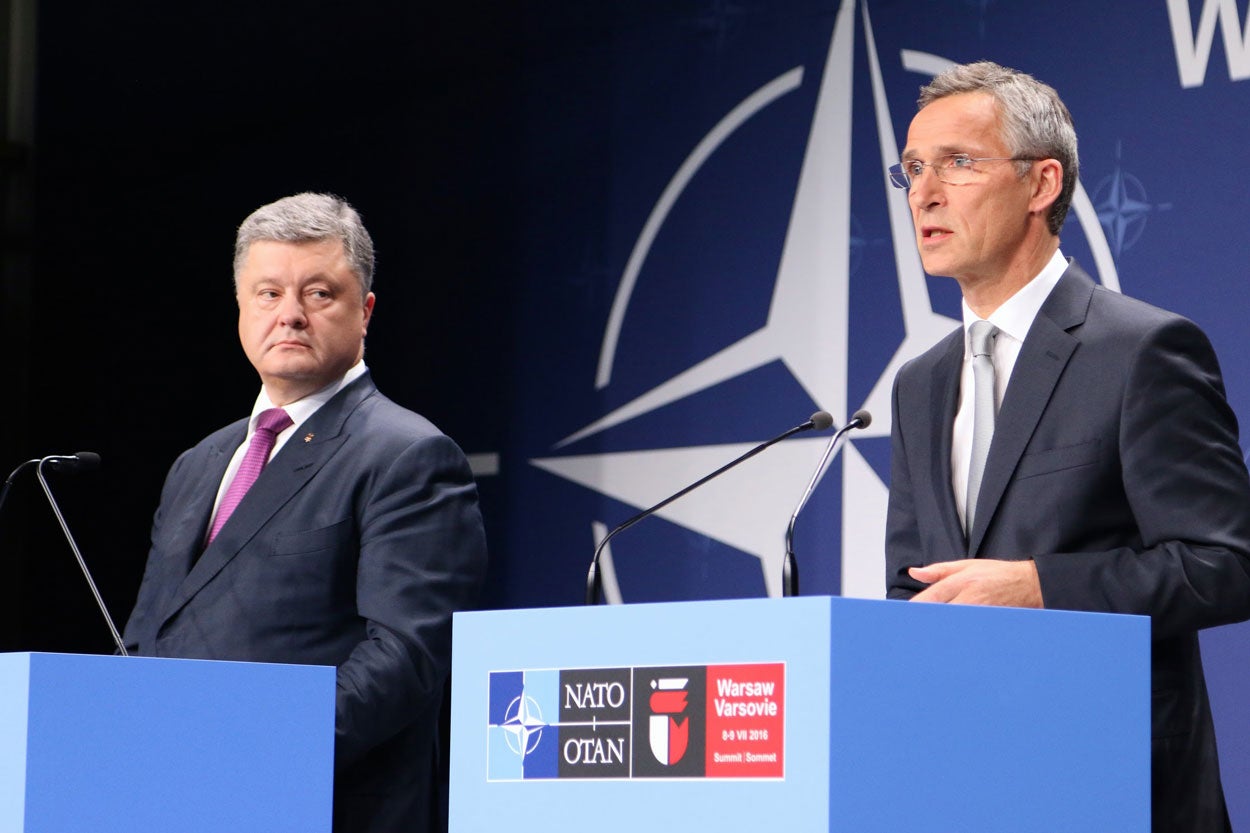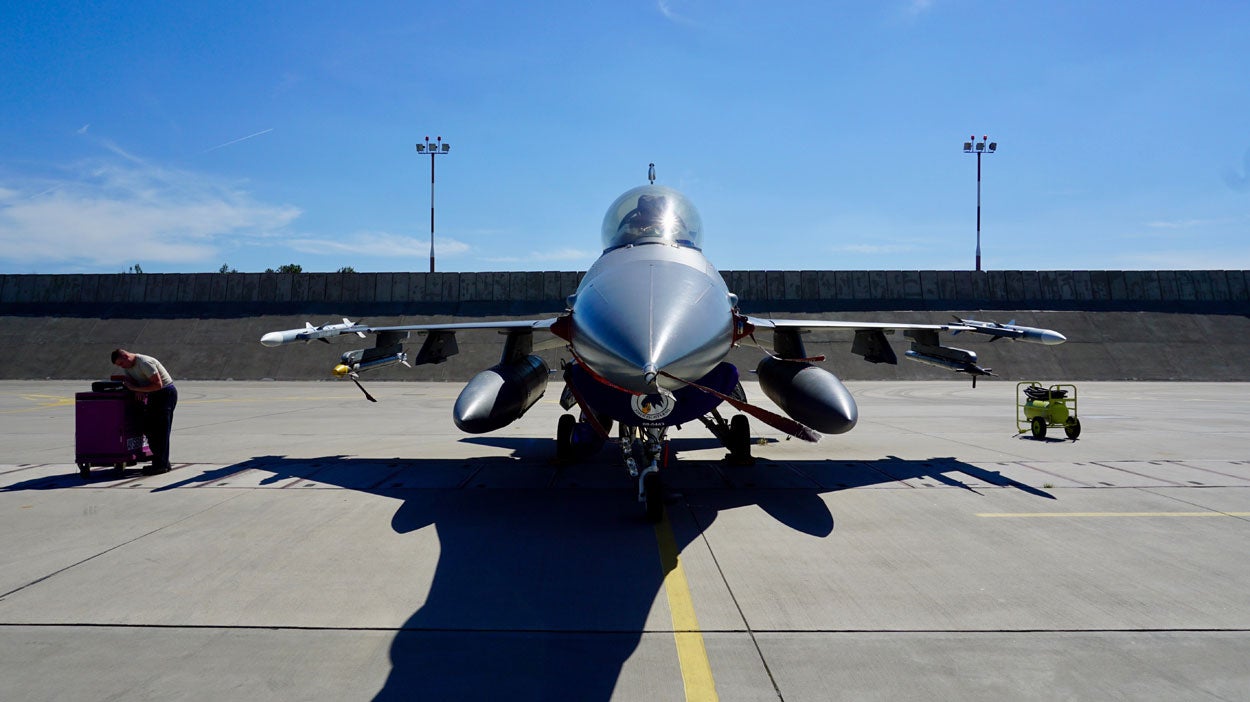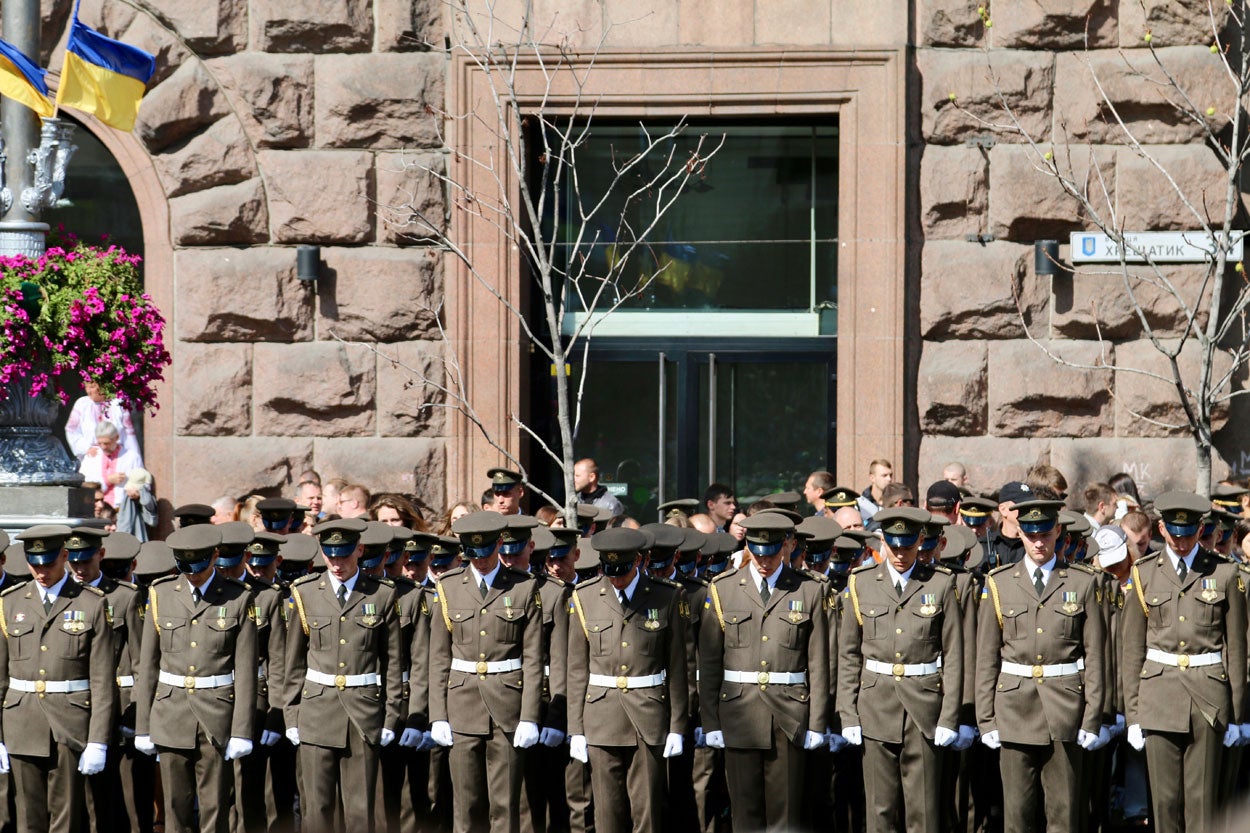NATO Braces for Putin’s Next Military Move in Eastern Europe
Nolan Peterson /
KYIV, Ukraine—Since 2014, Russian President Vladimir Putin’s military aggression in Ukraine has rearranged the national defense chessboards of countries across Eastern Europe.
In turn, the NATO military alliance has deployed weapons and troops eastward, to “make clear that an attack on one Ally would be considered an attack on the whole Alliance,” said NATO’s website. And the administration of U.S. President Donald Trump has approved delivery of American anti-tank weapons to Ukraine.
Yet, U.S. and NATO military leaders may have it wrong when it comes to anticipating Russia’s next military move in the region, a U.S. think tank says.
“The Russian military is well-positioned to launch a short-notice conventional war in Ukraine and a hybrid war in the Baltic states, the opposite of what Western leaders seem to expect in each theater,” Catherine Harris and Frederick Kagan wrote in a March joint report for the Institute for the Study of War and the American Enterprise Institute’s Critical Threats Project.
That assessment challenges U.S. and NATO military orthodoxy about what Russia’s next military offensive might look like.
“U.S. leaders and their European allies are unprepared for the ways in which Putin is poised to wage war in Ukraine and the Baltics,” Harris and Kagan wrote.
Yet, one thing seems certain—the Russian military threat to both the Baltics and Ukraine is not likely to taper off anytime soon. Putin’s rubber-stamp election victory March 18 guarantees at least another six years with the ex-KGB lieutenant colonel at the helm of Russian foreign policy.
“We are painfully aware that if there is a medium-intensity conflict and we are going to be part of it, it is going to be against Russia,” Maj. Ivo Zelinka, deputy commander of the Czech Republic army’s 43rd Airborne Battalion, told The Daily Signal.
“In addition,” Zelinka said, “Russia did learn a few new tricks since the Soviet times, but surely did not forget any.”

Ukrainian President Petro Poroshenko, left, beside NATO Secretary-General Jens Stoltenberg at the Western alliance’s 2016 summit in Warsaw. (Photos: Nolan Peterson/The Daily Signal)
Consequently, when it comes to military spending, Eastern Europe will be the fastest-growing region in the world in 2018, according to the annual Jane’s Defence Budgets Report.
“Growth has been particularly spectacular among the three Baltic states,” the report said, adding that by the end of 2018, defense spending among NATO’s Baltic countries of Estonia, Latvia, and Lithuania will have more than doubled in real terms compared to 2014 levels.
Similarly, since 2014, Ukraine has rebuilt its armed forces into the second-largest standing army in Europe, behind only Russia.
Russia’s defense budget has declined since its 2015 peak. Yet, Moscow appears to have repostured its military forces within its Western Military District, which borders on Ukrainian and NATO territory.
Harris and Kagan wrote for this month’s report for the Institute for the Study of War and American Enterprise Institute:
The ground forces deployments around the periphery of Ukraine give an indication of what preparations for a short-notice mechanized invasion might look like—pairs of regiments co-located under distinct headquarters along separate but converging lines of advance with well-secured rear-areas, all within 50 miles of the border. This disposition looks nothing like the ad hockery that would be required for a mechanized invasion of the Baltic states.
No Easy Task
Russia invaded and seized Ukraine’s Crimean Peninsula in March 2014. The following April, Moscow launched a proxy war in eastern Ukraine’s Donbas region.
Four years later, about 60,000 Ukrainian troops remain deployed along a 250-mile-long, entrenched front line in the Donbas opposite a force of about 35,000 pro-Russian separatists, foreign mercenaries, and Russian regulars. (Ukraine and NATO say about 3,000 Russian soldiers are operating in Ukraine, mainly in command and control roles.)
Europe’s only ongoing conflict has so far killed about 11,000 Ukrainians and displaced more than 1.7 million people. Stuck in an endless cycle of waxing and waning violence, it’s a static, trench conflict, comprising episodic artillery and rocket barrages as well as small arms gun battles. Despite punitive Western sanctions, Russia still feeds the conflict with weapons, cash, and its own troops.
Ukraine’s national security doctrine officially refers to Russia as the “aggressor nation.” Consequently, Ukraine has rebuilt and repositioned its armed forces specifically to defend against a Russian invasion.
Since 2014, Ukraine’s military center of gravity has shifted from its Soviet-legacy western bulwarks (meant to repel a NATO invasion) to the eastern border with Russia.
Also, Ukraine has increased its active force structure from 15 to 22 brigades, comprising more than 250,000 active troops, up from about 100,000 in 2014.
The country now fields “an entire new generation of combat-hardened commanders who know Russian weaknesses and how to exploit them,” wrote Phillip Karber, president of The Potomac Foundation, and Wesley Clark, NATO’s former supreme allied commander in Europe and a retired U.S. Army four-star general, in a report for the Potomac Foundation, a Washington think tank.
Ukraine’s military is still hobbled by a lack of arms, equipment shortfalls, and a need to modernize. Moreover, it remains outmatched in terms of troops, materiel, and technology by Russian forces in the region.
However, Ukraine’s army is “ready and trained” and “larger and stronger” than it was four years ago, Clark and Karber wrote, adding that a Russian attack on Ukraine is “not as easy as it looks.”
Détente No More
Relations between Russia and the West are worse than they have ever been in the post-Cold War era, many security experts say. And the Baltics are the tectonic boundary of those rising tensions, where the spectre of war looms most ominously.
“President Putin clearly appears to distrust NATO and harbor resentments toward it,” wrote RAND Corp., a U.S. defense think tank, in a 2016 report detailing the Russian military threat to NATO’s Baltic countries.
“[Putin’s] rhetoric suggests that he sees the Alliance’s presence on Russia’s borders as something approaching a clear and present danger to his nation’s security,” the RAND report added.
That report, titled “Reinforcing Deterrence on NATO’s Eastern Flank,” found, after multiple war games, that invading Russia forces could be at the gates of Estonia’s capital city of Tallinn and Latvia’s capital of Riga within 60 hours.
To reverse Moscow’s advantage, the report advocated a buildup of NATO air and land power in the region, to include seven NATO brigades permanently based in the Baltics, with three heavy armored brigades, supported by airpower, artillery, and other forces.
“A successful defense of the Baltics will call for a degree of air-ground synergy whose intimacy and sophistication recalls the U.S. Army-U.S. Air Force ‘AirLand Battle’ doctrine of the 1980s,” the RAND report stated.
Rattled, in part, by the RAND report’s findings, the alliance announced a plan during the 2016 NATO summit in Warsaw to build up its military forces in the Baltics by rotating four battalion-size, combat-ready battlegroups throughout the region—including 800 U.S. troops stationed in Poland.
NATO officials said the move constitutes the “biggest reinforcement of Alliance collective defense in a generation.”
Those rotating forces are now in place, supported by other temporary deployments of NATO airpower.
NATO also continues to run an air policing mission over the Baltics, which dates back to 2004. The 24/7 operation to defend Baltic airspace was run out of only one base in Lithuania until 2014, when it was expanded to include operations from Estonia’s Ämari Air Base.
Wrong Toolkit?
NATO’s military buildup in the Baltics may not be the right tool for the kind of threat Russian forces pose to the region, some experts say.
Russia has three motorized rifle brigades, one motorized regiment, and three airborne regiments based within close proximity to the Baltic states, according to open source reporting. Those forces are distributed within mainland Russia as well as Russia’s Kaliningrad exclave.
The special operations-heavy makeup of Russian forces within striking range of the Baltics telegraphs a readiness for the type of hybrid warfare assaults Russia conducted in Crimea and eastern Ukraine, the report by Harris and Kagan said.
“Russian military leadership, practice, and ad hoc deployment along the Baltic borders all suggest Putin is much more likely to pursue a hybrid approach in the Baltic over a conventional mechanized invasion,” they wrote.
Thus, to launch a conventional invasion of the Baltics, Russian commanders would have to shift mechanized forces from other locations in Russia toward the region, and expose Kaliningrad to a NATO counterattack.
With its constellation of spy satellites and other reconnaissance assets, NATO would notice Russia internally reinforcing its military forces on a scale required to mount a successful land invasion of the Baltics, thereby betraying the element of surprise.
In contrast, with three mechanized divisions along the Ukrainian border, and the concurrent headquarters already established to command those forces, Russia has the pieces in position to launch a land invasion of Ukraine on short order both from the north and from the east.
“Russia has strengthened its military presence on the border with Ukraine as several mechanized divisions are fully prepared for intervention,” Ukrainian President Petro Poroshenko said in a speech to Ukrainian troops last week.
In 2015, Russia re-established its 1st Guards Tank Army, which comprises about 700 tanks and which the Kremlin claimed could reach Kyiv in 48 hours.
In 2016, the Kremlin shifted its 20th Guards Army—with 400 tanks—from Moscow to the vicinity of Voronezh, which is about 400 kilometers, or 250 miles, closer to the Ukrainian border.
And in 2017, Russia re-established and began forward-deploying its 8th Guards Army—with about 900 tanks—near the Ukrainian border. Elements of the 8th Guards Army are deployed near Ukraine’s Donbas border to support Russian proxy forces within the breakaway region.
“There are three mechanized divisions near the Ukrainian border compared to just one airborne division near the Baltic, which would not be optimal for large-scale mechanized offensives,” Harris and Kagan wrote.
Learn by Example
So far in 2018, Russia’s proxy war in eastern Ukraine has quieted—the average number of cease-fire violations is at its lowest level in more than two years, international monitors say.
Yet, cease-fire violations are not the only measure of Russia’s ongoing aggression against Ukraine. Russian forces are waging a larger hybrid conflict that extends beyond the front lines in the Donbas, comprising weaponized propaganda, cyberwarfare, assassinations, and sabotage.
Russia also has used economic pressure as a weapon, such as cutting off natural gas supplies to Ukraine earlier this month amid a late-season cold snap, sparking an immediate countrywide heating crisis.
Similarly, Russia’s post-2014 brinkmanship against the West spans the gamut—aggressive warplane flybys of NATO aircraft and ships, global cyberattacks and disinformation campaigns, as well as meddling in European and American elections.
Russian relations with the West recently hit a new post-Cold War nadir following the attempted nerve gas murder of a former Russian spy and his daughter on British soil.
“The West would be foolish to over-focus on any one form of possible future war with Russia,” Harris and Kagan wrote in their report, adding that the deployment of NATO armor and airpower to build a defensive bulwark against a Russian land invasion of the Baltics may not be an effective deterrent.

A U.S. Air Force F-16 deployed to Poland in summer 2017 as part of an operation to deter Russian aggression in Eastern Europe.
Many Western military analysts say that Russia’s war in Ukraine is a case study in Moscow’s contemporary “hybrid warfare” doctrine. Therefore, along that line of thinking, Western military leaders would be wise to study Russian tactics in Ukraine to anticipate how a hypothetical Russian hybrid assault on a Baltic country would play out.
Echoing that sentiment, last week Poroshenko told reporters, “NATO nations could learn from Ukraine how to resist Russia.”
When he was U.S. president, Barack Obama levied punitive economic sanctions against Moscow for its military aggression in Ukraine. Obama also kick-started the U.S. military’s pivot to Eastern Europe.
Yet, despite years of appeals from Kyiv, Obama never approved sending Ukraine lethal weapons. Reportedly, the Obama White House feared such a move would escalate the conflict and spark a tit-for-tat arms race between Russia and the U.S. over Ukraine.
The Trump administration, however, has taken a tougher stance against Russia in both Ukraine and across Eastern Europe. Notably, it has approved the delivery of American anti-tank weapons to Ukraine and upped the budget for U.S. military operations in Eastern Europe to deter Russia.
The formidable U.S. Javelin anti-tank missiles—set for delivery to Ukraine this year—won’t be enough to tip the balance of power in Ukraine’s favor should Russia invade. Yet, the Javelins will increase the cost in blood and treasure that Russia would suffer in such a war.
More importantly, Trump’s decision to supply Kyiv with lethal weapons underscores both a commitment to Ukraine’s security as well as a commitment to deter Russia in Eastern Europe more broadly.
That’s a message, many believe, that Moscow is sure to consider when plotting its next move.
“Ukraine’s struggle against Russian revanchism is NATO’s,” Clark and Karber wrote. “It’s time the West recognize that.”



